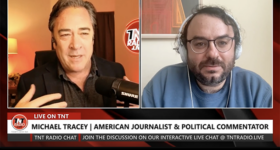 Andrew McKillop
Andrew McKillop
21st Century Wire
Big Spending – Small Prospects
Speaking at the Dec 10, 2013 Transatlantic Energy Security Dialogue, US national-security expert Lieutenant Colonel Daniel Davis said “We are betting our entire national economic life on the hope — indeed the expectation — that the fracking boom will continue until well into the 2020s”. He added that the high priced bet is being made on the belief by big energy companies that production rates and costs can be contained and that “significant amounts of ‘yet to be discovered oil” will somehow be found and produced to meet the demand.
In 2013, world major oil and gas corporations spent about $760 billion on exploration and production (E&P), beating the record they set in 2012 of about $700 billion.
At the same meeting as Daniel Davis, Geological Survey of Canada veteran David Hughes presented data he has compiled over several years on why oil and gas companies in North America have been forced to search “the sweet spots”, the most productive shale oil fields. This is due to both shale gas and oil production showing spectacularly high and early decline rates – causing the “Drill baby, drill” paradigm – and also due to the unreal and market-manipulated huge price premium on oil versus natural gas, only in North America.
Worldwide, major energy companies and their national government policy makers have engineered an impending and emerging crisis where the price and availability of energy are shifted into the permanent crisis zone. Oil prices are at extreme highs, worldwide. Gas and oil are both overpriced in Asia and Europe – where electricity prices are also extreme. At the same time, energy corporations have engineered a spiral of overspending on energy prospecting and development, carving big holes in their previous image of reliable investments paying reliable dividends.
Mortgage Backed Energy Security – Glut to Panic
As I noted in a recent article, “US Natural Gas Glut to Gas Panic”, the heavily hyped US natural gas boom is threatened by energy companies being forced to operate triage on their E&P. They have no choice but to treat “dry gas” finds with no “wet gas” liquids and synthetic light crude – able to be sold at or close to the oil price – as waste gas with no value. In the highly vaunted US-Canadian Bakken field, for example, around 30% of all gas production from this field is either flared or vented to the atmosphere. Only the “wet gas” is recovered.
Despite the triage however, and this applies worldwide, big energy companies have engaged an epic spending spree since 2008-2009 targeting all and any kind of energy. With no surprise, the profit warnings (and even sales revenue decline warnings) are coming thick and fast. One single example is Royal Dutch Shell which in 2013 had total corporate sales revenues of about $40.3 billion but spent about $44 billion on E&P.
In the run-up to the credit crunch of 2008, the financial coterie of banksters and brokers utilised exactly the same rhetoric now employed by big energy. They claimed the “financial model” of subprime loans was not only solid “but the only choice”. There was no alternative! Self-sustaining growth was sure and certain, the real estate sector of the US, and then the world, would lift off.
The rhetoric used by the financialized oil and gas corporations is that production volumes from existing “conventional or first-generation” oil wells is falling, and oil prices are high, so they have an increased incentive to borrow and spend, investing much more in E&P. The OPEC/nonOPEC rationale is then added – that OPEC controls the bulk of conventional lower production cost oil, so the big energy companies must invest more to find and produce oil and gas in “hostile and unconventional environments”.not controlled by the OPEC states and their NOCs.

IMAGE: Kashagan oil field in western Kazakhstan.
Results are a stepwise raise of capex or capital spending. One example is the recently completed but slow-growing Kashagan oil field, the present largest oil development outside the Middle East, with costs to date estimated at around or above $41 billion. Capex for this “new generation oil” venture is driven to extreme highs by the field’s installations needing protection from extreme weather, storm surges and attack from iceberg-sized floating blocks of ice. Capex by the majors in the US Gulf of Mexico is running at close to $10 bn a year, with the associated risk needing only the one word “Macondo” to explain it. Other offshore oil and gas spending is also extreme, for example offshore Brazil and both West and East Africa, but the majors say they also want to increase annual E&P for onshore oil and gas, almost anywhere in the world, at rates close to 10% a year “for several years”.
Onshore bets discard the OPEC/nonOPEC “energy security” rationale whenever this suits the argument for always spending more, at ever-higher risk. One example is the majors’ vast capex plans – and vast problems – in Iraq. Market watchers and self-styled advisers like Motley Fool claim the oilfield service companies, and the big energy corporations are “dividend stocks” to hold. It says “While they don’t garner the notoriety of high-flying growth stocks, they’re also less likely to crash and burn…..(and) over the long term, the compounding effect of their quarterly payouts, as well as their growth, adds up faster than most investors imagine”.
That might have been the case in the past but is not so sure today, and becomes less so by the day.
What Goes Up Stays Up, We Hope
The major oil and gas corporations are obliged to bet on extreme high oil prices, to justify ever-higher capex spending. Shell’s chief financial officer, Simon Henry, speaking in Oct 2013 said that for “short termists” their criticism of Shell’s big spending was a 1-0 victory for them but “we are five minutes into not just one game, but a premier league season.” Henry added: “Cutbacks in oil company investment to fund higher shareholder payouts will damage investors’ long term interests and encourage boom-bust oil prices just as such actions did at the turn of the century”.
Henry was referring to the 1999-2002 period in which oil prices bounced from around $10 – $12 per barrel, to around $25 – $30 per barrel. Following his implied logic, prices would be able to reach say $200 a barrel and stay there but today’s oil prices, conversely, in the real world have the stampt of being top-of-the-boom peak. Following the peak, they can fall at least 25% and stay lower – but for the majors, any significant retreat of oil prices will be a financial disaster.
To lure investors to the spending spree, high oil prices are therefore treated as a permanent godsend or “fact of life” to bolster the magic image of Treasure Trove. Outside the US, the carefully-maintained, artificially high natural gas prices operated in Europe and Asia add further spurious credence to the communications quest of the majors, who produce and sell gas both in the USA, and in Europe and Asia. They present and promote future energy as if it was gold doubloons filling antique chests.
In fact, the period of “maximum hype” by the majors, talking up investment prospects of today and revenue prospects of tomorrow can be quite accurately dated at 2009 to 2012. Since then, write downs of “junk assets” in the industry, worldwide, are often at the 75% level. One striking example is the offshore NW Australia gas production and LNG export shipping boom – which never happened despite the spending of well over $10 billion in initial expenses and capex. In this case, 75% write downs were the norm. The risks of the same process repeating with offshore east and west African oil and gas prospects (and many onshore African prospects) is either high or rising rapidly.
Another direct result is what market watchers call “the deal-making slump”, where oil and gas company A could sell off an enticing high value prospect to company B, and so on down the line, with big profits on the deal at each step. The original Charles Ponzi scheme used postage stamps, which of course “could only” increase in value each time they were passed on. That was the only difference.
The US shale gas acreage scam, which peaked in the period from early 2010 to late2012 at thousands of dollars per acre for multi-square-mile patches of “highly prospective” drilling land, was a great example of industry-scale mass delusion and hype. Apologists could claim, until 2013, that energy companies that built extreme-high debt during the rush to buy overpriced shale gas assets could sell off these assets later on, to fund their real world drilling programs.
Not when the “underlying asset” like the scraps of paper licensing shale gas exploratory drilling lose 75% of their nominal value in a few months.
By 2013, certainly in the US, the snakeoil-shale oil and gas financial play was over. The former scam of cheaply drilling a few wells, proclaiming a field “proved up”, and quickly selling the prospect to a few suckers no longer works. The victim buyers today are experiencing what is called “buyer’s remorse”. The oil and gas companies are stuck with their high-priced assets bought at the top of the boom, so they have to either drill or sell the asset at a huge discount. Elementary my dear Watson!
Always Unanticipated
One the most slapstick aspects of the farce, which causes grotesque wastes of both money and physical resources – for example drilling where nobody has any intention to ever produce – is that the vendors and promoters of the Energy Subprime scam are always “surprised” when their often-criminal asset expansion scams collapse. This “surprise” extends up to the highest corporate towers in the land – and both future and present energy consumers will be picking up the bill for a long time.
The US shale gas – rather than shale oil – scam was copybook snakeoil. Probably this year, perhaps a little later, it will have achieved the “unanticipated result” of actually causing US natural gas output to decline – years or in fact decades ahead of any possible geological depletion timetable. This is due to US natural gas prices being so low, that field operators are unable to depend on either asset sales to fund more drilling, or the cash generated by the wells producing underpriced gas, selling at a third or a quarter of gas prices in Europe or Asia. Their literal best option is to give up!
Only the lure of “wet gas” keeps the drillers drilling. Wet gas means gas containing oil of any kind, either light, heavy, synthetic or natural. Why oil in the US should be priced at about 3.33 times the price of gas on an energy-price basis is never discussed. Possibly it is a philosophical question that only the great minds at for example Goldman Sachs and the so-called energy market maker banks could answer, but big energy has to keep up the pretence that the overpricing of energy is permanent or “sustainable”.
Energy company capex running at about $760 billion in 2013 is based on the “anticipated premise” of totally artificial energy prices! When they fall – not if they fall – big energy will fall with them.
What would happen to Big Energy if oil prices declined to a market rational level, or in Europe and Asia if oil, gas and electricity prices declined to a market rational level, is not even worth imagining. Asset acquisition and E&P development spending in oil, oil and gas in Asia, and electricity in Europe is far ahead of the US natural gas subprime – meaning that any substantial decline of oil prices will be the trigger for an even more devastating rout than is being played out in the US today.
READ MORE FROM THIS AUTHOR AT: 21st Century Wire McKillop Files













